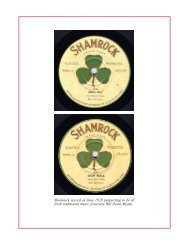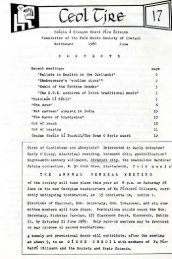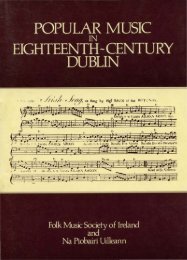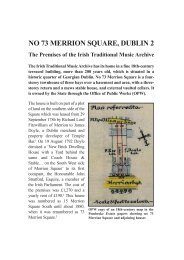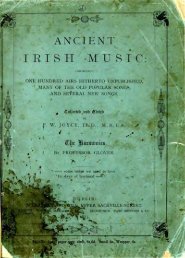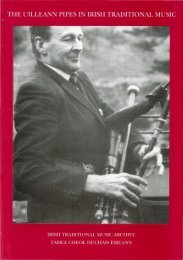Union Pipes - Irish Traditional Music Archive
Union Pipes - Irish Traditional Music Archive
Union Pipes - Irish Traditional Music Archive
You also want an ePaper? Increase the reach of your titles
YUMPU automatically turns print PDFs into web optimized ePapers that Google loves.
COURTNEY’S ‘UNION PIPES’ AND THE TERMINOLOGY OF IRISH BELLOWS-BLOWN BAGPIPES 94<br />
contemporary writer considered that ‘His ingenuity seems to have<br />
made a new discovery in Instrumental <strong>Music</strong>’. The pipes that these<br />
Londoners heard however would not have been new to his <strong>Irish</strong><br />
audiences, to the poor compatriots in London whose company he<br />
frequented, or to the provincial audiences among whom he had first<br />
made a reputation in Britain. They are unlikely to have been<br />
particularly new to those in Britain who had been hearing <strong>Irish</strong> pipes<br />
played informally and in private for some decades, such as Lady<br />
Luxborough in 1751, the British king George II before 1760, 340 the<br />
Scottish Highland piper Joseph MacDonald writing in 1760, blind<br />
James Mullin’s audiences in the George Inn in Derby in 1766, the<br />
employers of the young servant piper with the ‘real old Egan in<br />
Dublin’ set of pipes in 1779, the British music historian Charles<br />
Burney studying the instrument about 1785, 341 the artist and<br />
musician John Baptist Malchair sketching a ‘blind <strong>Irish</strong> piper’ and<br />
writing tunes from him in Oxford in 1785, 342 or the <strong>Irish</strong> slum<br />
celebrants of St Patrick’s Day in London in 1786.<br />
What was really new was the term ‘union pipes’, and under this term<br />
the audacious introduction to an elite audience, in classical music<br />
terms, of an improved form of an alien instrument often associated<br />
with the lower classes. There is nowadays a consensus, highly<br />
plausible but based seemingly on deduction rather than on any<br />
precise evidence, that an early eighteenth-century low-pitched and<br />
continuously sounding bellows pipes with a bell-like foot-piece<br />
(resembling but not identical to John Geoghegan’s ‘pastoral or new<br />
bagpipe’ one-piece chanter of 1743) was improved about the 1750s<br />
or 1760s by having its foot-piece removed. 343 The chanter tenon thus<br />
340<br />
Walker 1786: 81: ‘I have been informed that George II was so much<br />
delighted with the performance of an <strong>Irish</strong> gentleman on the Bagpipes, that he<br />
ordered a medal to be struck for him’. King George II died in 1760.<br />
341<br />
Letter to Joseph Cooper Walker, quoted in Walker 1786: 78–9.<br />
342<br />
Wollenberg 2007: 151–61.<br />
343<br />
For a statement of this hypothesis see Brooks 1985a.



